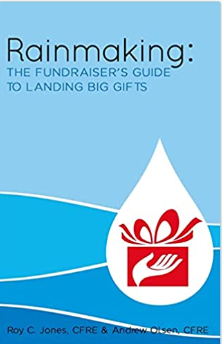I like to compare major donor development to the “rungs on a ladder”. The best fundraisers always use the donor’s giving history as the basis for determining how much that “next big ask” should be. Those that fail usually make the mistake of asking for too much or asking for too little.
The donor’s most recent contribution (MRC) and highest previous contribution (HPC) are the two best indicators for determining what the next level should be that they are to be upgraded too…. a.k.a. the next rung on the ladder.
It is very difficult to take a donor who has been giving just $1,000 and upgrade them to $25,000, even if you know they have the money. You have to move donors to higher giving levels incrementally, one rung at a time. Remember, major donors do not make gifts, they make investments. A good investor will make a gift and based upon the results they see… they will give a little more next time. The major donor wants to see how quickly they are thanked; did the gift get used as you said it would; did their gift have a measurable impact? In short, they want to confirm that your ministry or organization is a good steward of their money.
A $1,000 donor can be successfully asked for $50,000, $100,000 or more, but a response in the affirmative will the the exception, not the rule. The best option would be to take the time to build and cultivate the relationship. Explain the bigger need, but ask the donor to consider a gift of $5,000 or $10,000.
Some organizations get frustrated because they only have two rungs on their giving ladder: the low dollar $25 donors and the high dollar bequest or major gift. With no rungs or levels between entry level giving and major gifts it is almost impossible to take donors to the top of the giving pyramid.
Create needs lists, as well as, giving recognition levels and benefits which are natural benchmarks (giving levels) for your donor file and organization. Of course, this also gives you a process for prioritizing your donor visits and event strategies.
Here are a few tips for improving segmentation and moving donors up the giving ladder:
1. Set your giving levels so that they challenge your donors to increase their financial support: for example, $1,000, $5,000, $10,000, $50,000, $100,000.
2. Plan to establish at least three levels of giving recognition so donors see the progression in size of gifts – and thus upgrade their contributions: for example, $1000, $5000, and $10,000.
3. Select a name for identigy giving recognition levels. Conventional names include Century Club, President’s Society, Founder’s Club, Director’s Roundtable. Consider, however, names unique to your organization: the name of your founder, a famous member, a historical figure embodying your organization’s mission, or a concept important to your organization.
4. Determine the donor’s benefits at each level: plaques or certificates, autographed book, listing of name in program or annual report, access to key staff, invitations to special events.
5. Decide how and where you will recognize and publicize giving by donors at each level: newsletter, plaque, annual report, program, special brochure.
6. Identify board members and key donors who can “seed” each giving level with their contributions. Contact them personally to ask them to serve as charter members.
7. Prepare a brochure for each level: Describe how the giving at each level works, stipulating an annual contribution of at least $ _________ for (usually) unrestricted support.
State whether gift can be made in several payments – and whether deferred gifts will be counted (some organizations have a giving club just for those who’ve remembered the organization in their wills).
Identify and illustrate the benefits of membership. List charter members.
8. For higher-level giving, plan an annual special event such as a luncheon, dinner, or seminar. The president or executive director must be on hand. Consider inviting prominent person or special speaker. These events will encourage renewal of contributions.
9. At least once each year, list donors and giving levels (rungs on the ladder) in your newsletter, annual report, or (preferably) special publication.


